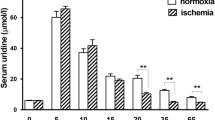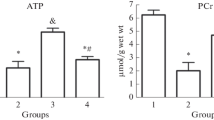Summary
The cardioprotective effects of a high dose of ascorbate on ischemia-reperfusion-induced myocardial damage were investigated using open chest anesthetized dogs. Two-hour occlusion of the left anterior descending coronary artery (LAD) induced mitochondrial dysfunction with a depletion of mitochondrial glutathione (GSH) concentration. Two-hour LAD occlusion followed by 1-h reperfusion worsened the ischemia-induced mitochondrial dysfunction together with a marked depletion of mitochodrial GSH concentration. Ascorbate reduced the mitochondrial dysfunction and prevented the depletion of mitochondrial GSH concentration after 2-h LAD occlusion and 1-h reperfusion. Activities of mitochondrial glutathione peroxidase and glutathione reductase did not change significantly in each group. Administration of ascorbate also prevented reperfusion arrhythmias without affecting blood pressure or heart rate. These results suggest that coronary reperfusion induces mitochondrial dysfunction and a depletion of mitochondrial GSH concentration, and that a high dose of ascorbate prevents reperfusion damage.
Similar content being viewed by others
References
Braunwald E (1976) Introductory remarks. Circulation 53 (Suppl I):I1–2
DeWood MA, Heit J, Spores J, Berg R, Selinger SL, Rudy LW, Hensley GR, Shields JP (1983) Anterior transmural myocardial infarction: Effects of surgical coronary reperfusion on global and regional left ventricular function. J Am Coll Cardiol 1:1223–1234
Kloner RA, Ellis SG, Lange R, Braunwald E (1983) Studies of experimental coronary artery reperfusion. Effects on infarct size, myocardial function, biochemistry, ultrastructure and microvascular damage. Circulation 68 (Suppl I):I8–15
Laschinger JC, Grossi EA, Cunningham JN, Krieger KH, Baumann FG, Colvin SB, Spencer FC (1985) Adjunctive left ventricular unloading during myocardial reperfusion plays a major role in minimizing myocardial infarct size. J Thorac Cardiovasc Surg 90:80–85
Ferrari R, Curello S, Boffa GM, Condorelli E, Pasini E, Guarnieri G, Albertini A (1989) Oxygen free radical-mediated heart injury in animal models and during bypass surgery in humans. Effects of α-tocopherol. Ann NY Acad Sci 570:237–253
Gauduel Y, Duvelleroy MA (1984) Role of oxygen radicals in cardiac injury due to reoxygenation. J Mol Cell Cardiol 16:459–470
Romaschin AD, Rebeyka I, Wilson GJ, Mickle DAG (1987) Conjugated dienes in ischemic and reperfused myocardium: An in vivo chemical signature of oxygen free radical mediated injury. J Mol Cell Cardiol 19:289–302
Peterson DA, Asinger RW, Elsperger KJ, Homans DC, Eaton JW (1985) Reactive oxygen species may cause myocardial reperfusion injury. Biochem Biophys Res Commun 127:87–93
Janero DR (1991) Therapeutic potential of vitamin E against myocardial ischemic-reperfusion injury. Free Radic Biol Med 10:315–324
Mickle DA, Li RK, Weisel RD, Brinbaum PL, Wu TW, Jackowski G, Madonik MM, Burton GW, Ingold KU (1989) Myocardial salvage with trolox and ascorbic acid for an acute evolving infarction. Ann Thorac Surg 47:553–557
Matsubara T, Itoh K, Nanki M, Nishimura K, Kambe T, Sugiyama S, Ozawa T, Sakamoto N (1983) Relationship between regional myocardial blood flow and mitochondrial function. Basic Res Cardiol 78:706–715
Hatefi Y, Jurtshuk P, Haavik AG (1961) Studies on the electron transport system. XXXII. Respiratory control in beef heart mitochondria. Arch Biochem Biophys 94:148–155
Hieda N, Toki Y, Sugiyama S, Ito T, Satake T, Ozawa T (1988) Prostaglandin I2 analogue and propranolol prevent ischaemia-induced mitochondrial dysfunction through the stabilisation of lysosomal membranes. Cardiovasc Res 22:219–225
Tieze F (1969) Enzymic method for quantitative determination of nanogram amounts of total and oxidized glutathione. Anal Biochem 27:502–522
Griffith OW (1980) Determination of glutathione and glutathione disulfide using glutathione reductase and 2-vinylpyridine. Anal Biochem 106:207–212
Floré L, Günzler WA (1984) Assays of glutathione peroxidase. In: Packer L (ed) Methods in enzymology, vol. 105. Oxygen radicals in biological systems. Academic, Now York, pp 114–121
Sugiyama S, Hayakawa M, Kato T, Hanaki Y, Shimizu K, Ozawa T (1989) Adverse effects of anti-tumor drug, cisplatin, on rat kidney mitochondria. Biochem Biophys Res Commun 159:1121–1127
Carlberg I, Mannervik B. (1985). Glutathione reductase. In: Meister A (ed) Methods in enzymology: Glutamate, glutamine, glutathione, and related compounds, vol. 113. Academic, New York, pp 484–490
Omaye ST, Turnbull JD, Sauberlich HE (1979) Selected methods for the determination of ascorbic acid in animal cells, tissues, and fluids. In: McCormick DB, Wright LD (eds) Methods in enzymology, vol. 62. Vitamines and coenzymes. Academic, New York, pp 3–11
Kajiyama K, Pauly DF, Hughes H, Yoon SB, Entman ML, McMillin-Wood JB (1987) Protection by verapamil of glutathione equilibrium and phospholipid changes during reperfusion of ischemic canine myocardium. Circ Res 61:301–310
Curello S, Ceconi C, Bigoli C, Ferrari R, Albertini A, Guarnieri C (1985) Changes in the cardiac glutathione status after ischemia and reperfusion. Experientia 41:42–43
Kuzuya T, Hoshida S, Nishida M, Kim Y, Fuji H, Kitabatake A, Kamada T, Tada M (1989) Role of free radicals and neutrophils in canine myocardial reperfusion injury: Myocardial salvage by a novel free radical scavenger, 2-octadecylascorbic acid. Cardiovasc Res 23:323–330
Sugiyama S, Ozawa T, Kato T, Suzuki S (1980) Recovery time course of ventricular vulnerability after coronary reperfusion in relation to mitochondrial function in ischemic myocardium. Am Heart J 100:829–837
Hanaki Y, Sugiyama S, Hieda N, Taki K, Hayashi H, Ozawa T (1989) Cardioprotective effects of various antiarrhythmic drugs in canine hearts. J Am Coll Cardiol 14:219–224
Sano T, Sugiyama S, Taki K, Hanaki Y, Shimada Y, Ozawa T (1990) Effects of antiarrhythmic agents classified as class III group on ischaemia-induced myocardial damage in canine hearts. Br J Pharmacol 99:577–581
Author information
Authors and Affiliations
Rights and permissions
About this article
Cite this article
Nishinaka, Y., Sugiyama, S., Yokota, M. et al. The effects of a high dose of ascorbate on ischemia-reperfusion-induced mitochondrial dysfunction in canine hearts. Heart Vessels 7, 18–23 (1992). https://doi.org/10.1007/BF01745863
Received:
Revised:
Accepted:
Issue Date:
DOI: https://doi.org/10.1007/BF01745863




